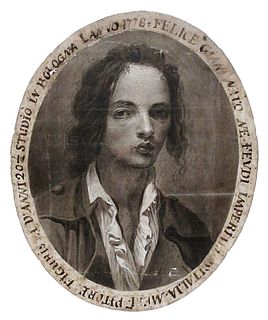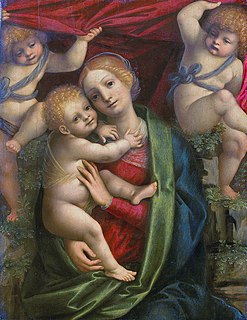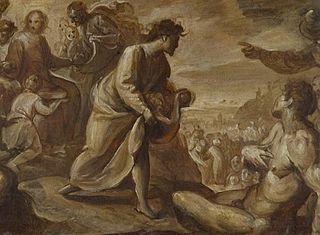Related Research Articles

Pavia is a town and comune of south-western Lombardy in northern Italy, 35 kilometres south of Milan on the lower Ticino river near its confluence with the Po. It has a population of c. 73,086. The city was the capital of the Kingdom of the Lombards from 572 to 774.

Giovanni Antonio Scopoli was an Italian physician and naturalist. His biographer Otto Guglia named him the "first anational European" and the "Linnaeus of the Austrian Empire".

Ambrogio Borgognone was an Italian painter of the Renaissance period active in and near Milan.

Guglielmo Caccia called il Moncalvo was an Italian painter of sacred subjects in a Mannerist style.

Vincenzo Foppa was an Italian painter from the Renaissance period. While few of his works survive, he was an esteemed and influential painter during his time and is considered the preeminent leader of the Early Lombard School. He spent his career working for the Sforza family, Dukes of Milan, in Pavia, as well as various other patrons throughout Lombardy and Liguria. He lived and worked in his native Brescia during his later years.
San Genesio ed Uniti is a comune (municipality) in the Province of Pavia in the Italian region Lombardy, located about 25 km south of Milan and about 11 km northeast of Pavia. As of 31 December 2004, it had a population of 3,567 and an area of 9.0 km².

Francesco Cairo, also known as Francesco del Cairo, was an Italian Baroque painter active in Lombardy and Piedmont.

Bernardino Gatti was an Italian painter of the Renaissance, active mainly in Parma and Cremona. He is also commonly called il Sojaro.

Felice Giani was an Italian painter of the Neoclassic style. His grand manner subjects often included Greco-Roman allusions or themes.

Bernardino Lanini or Lanino was an Italian painter of the Renaissance period, active mainly in Milan.

Filippo Abbiati (1640–1715) was an Italian painter of the early-Baroque period, active in Lombardy and Turin, together with Andrea Lanzani and Stefano Maria Legnani, he was a prominent mannerist painters from the School of Lombardy. Born in Milan, he was a pupil of the painter Antonio Busca. Alessandro Magnasco was one of his pupils along with Pietro Maggi and Giuseppe Rivola. Ticozzi claims he trained, along with Federigo Bianchi, with Carlo Francesco Nuvolone. Along with Bianchi, he painted the cupola of Sant'Alessandro Martire in Milan. Abbiati also painted a St. John preaching in the Wilderness for a church in Saronno.
Ranunzio Prata was an Italian painter. He was born in Milan, and painted in Pavia around 1635. He may be the author of an altarpiece at San Francesco, Brescia.

Bartolommeo Bonone, also called Bartolomeo Bernardi, was an Italian painter of the Renaissance period.
Vincenzo degli Azani was an Italian painter, active mainly in his native Palermo, except for a spell in Rome, where he came under the influence of Raphael. He is also known as Vincenzo da Pavia, Vincenzo Aniemolo, Vincenzo degli Azani da Pavia, Il Romano and Vincenzo Romano.
Bernardino Lanzani was an Italian painter of the Renaissance, active mainly in Pavia and Bobbio.

Andreas Ritzos also known as (Rico, Ricio, Rizo). He was a Greek icon painter, from Crete. Ritzos is considered one of the founding fathers of the Cretan School. He was affiliated with Angelos Akotantos. Most of his work stylistically follows the traditional maniera greca. His children, grandchildren, and great-grandchildren were also painters. He was one of the most influential painters of the Cretan School along with Andreas Pavias and Angelos Akotantos. He influenced the works of Georgios Klontzas, Nikolaos Tzafouris, Theophanes the Cretan, Michael Damaskinos and El Greco. According to the Institute for Neohellenic Research, sixty of his paintings have survived.

Pietro Sorri (1558-1622) was an Italian painter active in Siena.

Andreas Pavias was a Greek painter and educator. He was a representative of the Cretan School. His teacher was Angelos Akotantos. He was affiliated with Andreas Ritzos. His style began to incorporate the Venetian school. He experimented with different techniques. He is one of the founding fathers of the Cretan School. Angelos Pitzamanos was his student for five years. His works influenced countless artists both Italian and Greek. His paintings were in many churches and private collections in both geographic areas. He also influenced the works of other artists of the Cretan School namely Theodore Poulakis, Georgios Klontzas, Michael Damaskenos and many others. His most famous work is the Crucifixion of Jesus. Seven of his works survive today, six bear his signature.

Ioannis Moskos was a Greek painter that migrated to Venice. Two other very famous painters with the name Moskos were active around the same period Elias Moskos and Leos Moskos. Leos Moskos frequently traveled all over the Venitian Empire and was in Venice around the same period as Ioannis. He is not Elias Moskos's son. The Moskos painters may have had some relationship but documentation is unavailable. Ioannis painted in the traditional maniera greca and the Venetian style. His art resembles Michael Damaskinos and Andreas Pavias. He was affiliated with the church of San Giorgio dei Greci. He left a huge assortment of paintings that can be found all over the world. His most popular work is The Crucifixion.

The Crucifixion is a painting created by Georgio Markazini. Markazini was a Greek painter from the island of Crete. He migrated to Venice. He was active during the middle part of the 17th century. Two of the painter's works survived. The crucifixion was a very popular subject among Cretan painters. Andreas Pavias, Emmanuel Lambardos, and Theophanes the Cretan created a similar style crucifixion. The Cretan painters frequently influenced each other.
References
- Bryan, Michael (1889). Walter Armstrong; Robert Edmund Graves (eds.). Dictionary of Painters and Engravers, Biographical and Critical. Vol. II L-Z. London: George Bell and Sons. p. 633.